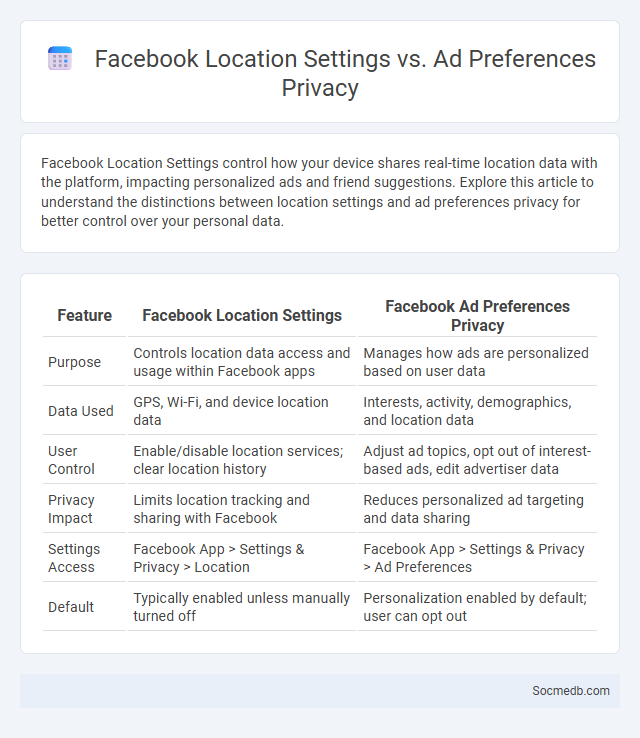
Photo illustration: Facebook Location Settings vs Ad Preferences Privacy
Facebook Location Settings control how your device shares real-time location data with the platform, impacting personalized ads and friend suggestions. Explore this article to understand the distinctions between location settings and ad preferences privacy for better control over your personal data.
Table of Comparison
| Feature | Facebook Location Settings | Facebook Ad Preferences Privacy |
|---|---|---|
| Purpose | Controls location data access and usage within Facebook apps | Manages how ads are personalized based on user data |
| Data Used | GPS, Wi-Fi, and device location data | Interests, activity, demographics, and location data |
| User Control | Enable/disable location services; clear location history | Adjust ad topics, opt out of interest-based ads, edit advertiser data |
| Privacy Impact | Limits location tracking and sharing with Facebook | Reduces personalized ad targeting and data sharing |
| Settings Access | Facebook App > Settings & Privacy > Location | Facebook App > Settings & Privacy > Ad Preferences |
| Default | Typically enabled unless manually turned off | Personalization enabled by default; user can opt out |
Understanding Facebook’s Location Settings
Facebook's location settings allow users to control how their geographic data is shared and used across the platform, enabling features like check-ins, nearby friends, and localized ads. Users can manage location permissions on both the Facebook app and device settings, choosing whether to enable precise or approximate location tracking. Understanding these settings enhances privacy management and tailors the user experience based on geographic relevance.
Overview of Facebook Ad Preferences
Facebook Ad Preferences allow users to control the types of ads they see by managing interests, advertisers, and personal data used for targeting. These settings provide insight into categories such as demographics, activities, and online behavior that shape ad personalization. Adjusting preferences enhances ad relevance while maintaining user privacy across Facebook's extensive advertising network.
What Are Facebook Privacy Settings?
Facebook privacy settings control who can see your posts, personal information, and activity on the platform, allowing users to customize their audience for enhanced security. These settings include options for managing profile visibility, limiting friend requests, and controlling data sharing with third-party apps. Adjusting Facebook privacy settings helps protect user data, prevent unauthorized access, and maintain online privacy.
Location Settings vs Privacy Settings: Key Differences
Location settings on social media platforms allow users to share geographic information tied to posts, enabling location-based content and targeted advertising. Privacy settings control who can access a user's profile, posts, and personal data, offering customization over visibility and data sharing. These distinct settings collectively shape user experience by balancing personalization through location data and protection of personal information from unwanted exposure.
How Ad Preferences Affect Your Privacy
Ad preferences on social media platforms often dictate the type of personal data collected, including browsing behavior, location, and demographic information, which directly impacts user privacy. By adjusting these settings, users can limit targeted ads and reduce the amount of sensitive data shared with advertisers and third-party companies. Understanding and managing ad preferences is essential for maintaining control over personal information and minimizing privacy risks in digital environments.
Managing Your Location Data on Facebook
Managing your location data on Facebook involves adjusting privacy settings to control how and when your location is shared. Use Facebook's Location History settings to view, enable, or disable tracking, ensuring only authorized apps and services access your geographic information. Regularly reviewing and deleting stored location data helps maintain your privacy and prevents unwanted sharing with third parties.
Controlling Personalized Ads through Ad Preferences
Controlling personalized ads through ad preferences empowers you to customize the types of advertisements you see on social media platforms, enhancing your online experience by reducing irrelevant content. By adjusting settings in your ad preferences, you can limit data tracking and choose which categories of ads are displayed based on your interests or browsing behavior. Regularly updating these preferences helps maintain better privacy control and ensures that social media algorithms serve ads that match your current needs and preferences.
Balancing Privacy: Location, Ads, and General Settings
Managing social media privacy requires a careful balance between location sharing, targeted ads, and general account settings to protect personal information. Users should regularly review location permissions and ad preferences to limit data exposure and control how their information is used by advertisers. Adjusting privacy settings, such as profile visibility and data sharing options, enhances security while maintaining a personalized social media experience.
Tips to Enhance Privacy on Facebook
Adjusting your Facebook privacy settings is crucial to protect Your personal information from unwanted access. Use the audience selector to control who sees your posts, limit profile visibility, and regularly review apps connected to your account to remove unnecessary permissions. Enabling two-factor authentication adds an extra layer of security to Your Facebook login, safeguarding against unauthorized access.
Best Practices for Safe Facebook Usage
To ensure safe Facebook usage, regularly update privacy settings to control who can view your profile and posts, limiting exposure to potential threats. Enable two-factor authentication for enhanced account security and avoid sharing sensitive personal information that could be exploited. Monitor friend requests carefully and report suspicious activity or fake profiles to maintain a secure online environment.
 socmedb.com
socmedb.com